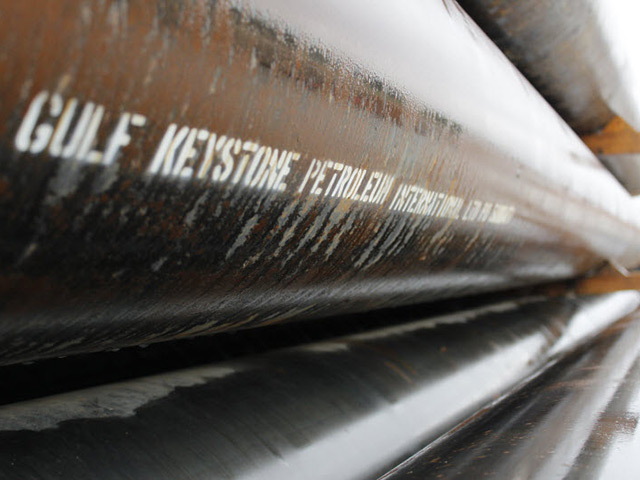
President Donald Trump is about to deliver his promise to approve the controversial Keystone XL oil pipeline – but the development’s opponents are ready to challenge.
The battle is now shifting from demonstrations to courtrooms, and a Nebraska agency and congressional town hall meeting, where environmental activists and landowners have plotted ways to keep blocking the pipeline TransCanada Corp. has been trying to build for more than eight years. Just winning Nebraska regulators’ approval for Keystone XL’s route through the state could take TransCanada another six months.
Anthony Swift, an attorney with the Natural Resources Defense Council that opposes Keystone explained.
He said: “A federal approval of the permit is not the end of the line for this project; there’s still many obstacles.
“There’s legal challenges, there’s the Nebraska issues and, frankly, there are the economic and market obstacles.”
The State Department will issue a permit for the project within days, according to people familiar with the planning, abiding by a Monday deadline the president laid out when he invited TransCanada to reapply for approval earlier this year. Representative Kevin Cramer, a North Dakota Republican, said the White House has told him the permit will be issued “very soon.”
White House spokesman Sean Spicer said on Thursday: “We’ll have an update on that tomorrow.”
The decision would reverse former President Barack Obama’s rejection of the $8 billion project in 2015, after a State Department review concluded Keystone XL did not serve the national interest. The pipeline is slated to carry as much as 830,000 barrels of oil per day from Alberta, Canada, crossing 1,179 miles (1,897 kilometers) and cutting through Montana and South Dakota on its way to Steele City, Nebraska. From there it will join a southern leg that flows to Gulf Coast refineries.
TransCanada spokesman Terry Cunha said the company anticipates a decision by the State Department within the 60-day window that closes Monday. Cunha added: “At the moment, we continue to work with the Administration on our Presidential Permit application.”
Keystone has long been a flash point for fossil fuel opponents who argue it will encourage the development of Canadian oil sands crude, which generally requires more energy to extract and process. Landowners also say it endangers drinking water resources in America’s heartland.
Those same opponents who chained themselves to bulldozers, rallied at the White House and forced route revisions in Nebraska now are plotting a multipronged legal attack as well as protests in the pipeline’s path.
Sara Shor, a campaign manager for the climate advocacy group 350.org, vowed to “raise hell at the national level” and recruit millions of people to fight the project, including by highlighting their concerns during lawmakers’ town halls during a planned congressional recess next month.
She said: “We’re going to continue to make Keystone XL a political issue and push every elected official to come out against this project if they care about communities, local rights, eminent domain, air, water and climate.
“It just touches so many issues.”
Environmental groups are slated to file at least one legal challenge right away – arguing that the State Department violated the National Environmental Policy Act by approving Keystone on the basis of a three-year-old analysis of the project that was issued when oil prices were nearly double what they are now.
West Texas Intermediate crude oil, the U.S. benchmark, traded near $100 a barrel when the State Department’s final environmental study was issued in January 2014 but has slumped by roughly half, now hovering near $50 a barrel. That comes after a prolonged rout that sent crude plummeting to nearly $26 in 2016.
avid Turnbull, campaigns director with Oil Change International, said: “The oil market has shifted and will always be shifting, and it’s really not adequate to rely on old analysis to approve this pipeline.”
That earlier analysis was built around assumptions about prices and the availability of rail transport and alternatives for moving Canadian oil sands crude that have not come to pass, Swift said.
Swift added: “The weaknesses of an approval at this stage and the legal vulnerabilities of that approval are apparent.
“Moving forward solely on the basis of an objectively outdated environmental review on a pipeline that doesn’t have a full route does pose a lot of problem for the legality of the approval.”
Other legal challenges will play out in Nebraska, where energized landowners have already forced changes to the project during previous reviews. At least three groups opposed to Keystone have filed intervenor applications with the state’s Public Service Commission, seeking to make their case against the project during public hearings.
TransCanada submitted an application to the commission last month, triggering a 210-day period for the agency to decide whether the company demonstrated the project serves the public interest. That points to a decision in September — if the Public Service Commission’s review is not extended for an additional five months.
If TransCanada wins state approvals and invokes eminent domain to claim land for pipeline construction, the activist group Bold Alliance will file a lawsuit challenging the action, said Jane Kleeb, president of the organization.
Separate challenges may play out in South Dakota, where opponents earlier this month asked a judge to reverse an authorization critical to its path through the state.
All of the activity means that Keystone’s “best-case scenario for coming online” is the second half of 2019, Bloomberg Intelligence analysts said.